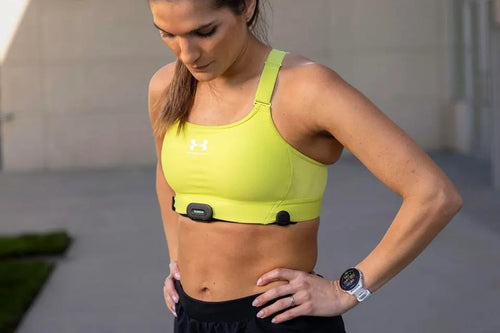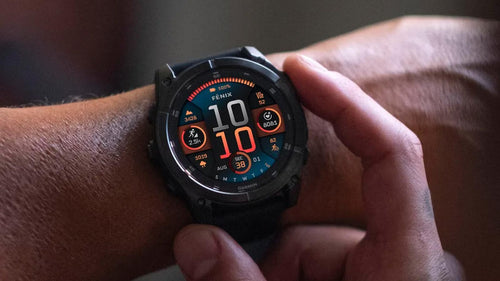The HRM-Swim is Garmin’s latest heart rate monitor strap, aimed at (surprise, surprise) swimmers! The team at Highly Tuned Athletes provided me with a unit to test while I was away and had plenty of free time to get reacquainted with swimming laps.
HRM-Swim: Why you need it
I have a really, really short attention span and I tend to get bored really, REALLY quickly. I do enjoy swimming but, due to the aforementioned propensity to lose focus the process of staring at the black line up and down the pool just doesn’t do it for me.
My concentration wanes, I lose rhythm, forget what I am doing, lose my lap count and then give up. I mostly get around these issues by wearing a waterproof iPod and headphones while swimming, or just not swimming.
I still forget how many laps I have done more often than not but there is not but this all changed with the release of the Garmin Forerunner 920XT and fenix 3 watches which have the swim and lap counting function, sweet. The only thing really missing was the ability to see how hard you are actually training, apart from the gasping for air at the end of an effort.
Garmin powered swimmers rejoice, you can now quantify your time spent in the pool as they have released their swim capable heart rate monitoring strap, the HRM-Swim.
Currently the HRM-Swim is compatible with the following Garmin watches:
- fenix 3 (including Sapphire)
- fenix 3 Sapphire HR
- epix
- Forerunner 920XT
- tactix Bravo
- vivoactive HR (upon release)
HRM-Swim: What does it do?
Pretty simple really, it measures your heart rate while you are swimming. Basically all of your heart rate data is being stored (cached) within the HRM-Swim transmitter itself and is then uploaded to your watch at the completion of your activity when it is saved.
Just be aware that if your chest is underwater you are not going to see your heart rate displayed on your watch so don’t freak out like I did the first time wondering what you did wrong. I was about to get out of the pool when I noticed it picked up the signal on my watch as soon as the strap was barely above the water.
HRM-Swim: Where can you use it?
What is the difference between this HRM-Swim strap and the regular HRM-Run strap? Well a lot actually. For starters the HRM-Swim doesn’t capture the advanced running metrics that the HRM-Run will, and the HRM-Run is not suitable for the submersion you experience when swimming. The strap is also a bit wider and it has a sticky rubber coating on the body side of it.
This provides the strap with a lot more grip on your torso so that it does not slip off during your activity, even when kicking hard off the wall. Hairy men be warned; the texture and coating of the inside of this strap could get uncomfortable and a little “pully” if you roll a chest rug. The HRM-Swim strap has noticeably less elasticity or give compared to the HRM-Run strap and other straps on the market. I was initially a bit sceptical regarding this as I felt it could be a little restrictive around the chest.
Once I was moving around in the water it felt fine and did not affect me whether I was breaststroking, freestyling or dog paddling. I believe that the reason behind this modification is to keep the strap from sliding down your body during a swim activity. The HRM-Swim transmitter on the strap does not have the same streamlined profile of the RUN pod, instead it is the same thickness all round. I am not sure why this is but it did not affect the comfort during my testing.
Another thing with the HRM-Swim transmitter is that it is not removable from the strap like traditional Garmin transmitters. You are still able to replace the coin battery inside of it by taking off the blue rubber cover and accessing the screws beneath it. Finally the most obvious difference between the bands is the colour.
Probably a good thing as I don’t think the HRM-Swim would be too flash while running, and swimming with the HRM-Run is just not going to end well and should stop the user from accidentally grabbing the wrong band if in a hurry to get out the door.
HRM-Swim: Helpful tips
Unlike other straps you don’t need to wet this one prior to use, but if you want to ensure that everything is working correctly prior to hitting the start button I would suggest you give it a squirt or a lick. The operation is pretty basic from here on.
Put the strap around your chest, select your swim related activity, ensure that the strap is found and connected (wait for GPS lock if doing an open water swim), hit start – do your activity, hit pause and then save your activity. This is where the watch will download the heart rate data from your strap. This doesn’t take long at all but the duration is dependent on the length of the activity.
Note: reading through the Garmin forums and other sites the other available HRM strap, the HRM-Tri, is not suitable for pool swimming purposes. This is the express purpose of the HRM-Swim. The HRM-Tri is designed for open water swimming, running (captures advanced running metrics) and cycling; perfect for triathletes in other words. Just letting you know so you don’t think of getting just the HRM-Tri as an all-in-one option.
HRM-Swim: Conclusion
This is Garmin’s first crack at a HRM strap for swimmers and it worked really well for me. I had no issues with the band slipping off while in the middle of an activity and the heart rate recorded appeared accurate with no random spikes occurring throughout the activity (as you can see in the screen capture from my Garmin Connect profile).
I cannot compare it to the other straps available but if you have one of the compatible Garmin watches and you are after swim-capable heart rate monitoring then it really is a no brainer to get the HRM-Swim.
The Garmin HRM-Swim strap is available from Highly Tuned Athletes.
The post Garmin HRM-Swim: Review appeared first on Highly Tuned Athletes.


